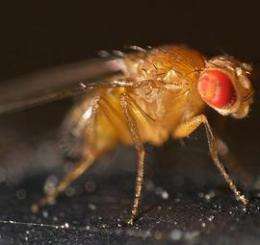February 14, 2012 report
Researchers induce freezing tolerance in fruit fly

Bob Yirka
news contributor

(Â鶹ÒùÔºOrg.com) -- Most of what is known about the ability of some cold blooded animals and several insects to survive having their body temperature fall below freezing has led to the conclusion that those organisms that can do it are unique to the extent that trying to emulate those same abilities or techniques in other organisms is just not feasible. But that may change now that a team from the Czech Republic has succeeded in partially freezing a fruit fly, and then resurrecting it, using, as they describe in their paper published in the Proceedings of the National Academy of Sciences, a technique copied from a close relative.
Insects that are able to withstand being frozen rely on one of two techniques. They either secrete substances that allow them to control the process of freezing, or they build up proteins that serve as a form of anti-freeze, which prevents their cells from freezing.
In the experiment run by the Czech team, the subarctic fly, Chymomyza costata, was analyzed to see which techniques it uses to survive being frozen for lengthy periods of time. They found it actually used a two step process. First, the fly adjusts its hormones allowing it to stop all cell development, a process called a diapause. Then, it relied on the amino acid proline to help protect it from the effects of subfreezing temperatures.
To see if they could coax another organism to use the same technique, the team turned to the common fruit fly, an insect that prefers warm climates and generally dies when exposed to freezing temperatures. And while the fruit fly doesn’t have the ability to go into a diapause, it does have the ability to ability to enter a quiescence state if subjected to a harsh environment. To make this happen, the team subjected some of the fruit flies to alternating near freezing and warmer conditions for several cycles, then subjected them to -5° C for a half hour. They found that going into the quiescence state alone allowed six percent of the fruit flies to survive.
They then tried the same thing again with another group of fruit flies, but this time the flies were fed a diet of proline first. Doing that, the team found, improved the insects’ chances dramatically as they found that sixty one percent of the fruit flies were then able to survive the freezing test. And ten percent of those survived to adulthood and produced healthy offspring.
This experiment doesn’t mean true cryogenics is just around the corner, of course, but it might lead to new advances in preserving cells for use in research or perhaps even help store tissue for later use.
Written for you by our author —this article is the result of careful human work. We rely on readers like you to keep independent science journalism alive. If this reporting matters to you, please consider a (especially monthly). You'll get an ad-free account as a thank-you.
More information: Conversion of the chill susceptible fruit fly larva (Drosophila melanogaster) to a freeze tolerant organism, PNAS, Published online before print February 13, 2012,
Abstract
Among vertebrates, only a few species of amphibians and reptiles tolerate the formation of ice crystals in their body fluids. Freeze tolerance is much more widespread in invertebrates, especially in overwintering insects. Evolutionary adaptations for freeze tolerance are considered to be highly complex. Here we show that surprisingly simple laboratory manipulations can change the chill susceptible insect to the freeze tolerant one. Larvae of Drosophila melanogaster, a fruit fly of tropical origin with a weak innate capacity to tolerate mild chilling, can survive when approximately 50% of their body water freezes. To achieve this goal, synergy of two fundamental prerequisites is required: (i) shutdown of larval development by exposing larvae to low temperatures (dormancy) and (ii) incorporating the free amino acid proline in tissues by feeding larvae a proline-augmented diet (cryopreservation).
Journal information: Proceedings of the National Academy of Sciences
© 2011 Â鶹ÒùÔºOrg.com














